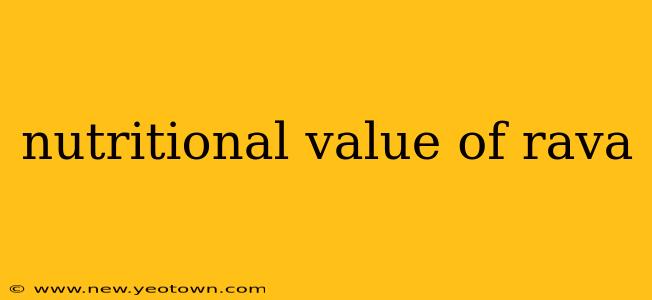Rava, also known as sooji or semolina, is a staple ingredient in many South Asian and Middle Eastern cuisines. But beyond its culinary versatility, rava boasts a surprising nutritional profile that deserves a closer look. This isn't just about fluffy idlis and crispy dosas; it's about understanding the nutritional benefits this humble ingredient offers. Let's embark on a journey to uncover the hidden nutritional wealth within rava.
What is Rava Made From?
Before we delve into the nutritional details, it's important to understand what rava actually is. Rava is made from durum wheat, a type of wheat known for its high protein content. The durum wheat is processed, ground, and then sifted to create the fine, granular texture we recognize as rava. This process removes the bran and germ, resulting in a refined grain. This refinement impacts the nutritional profile, as we'll see later.
What are the Key Nutrients in Rava?
Rava is a good source of several essential nutrients, though the exact amounts vary based on the type of wheat used and the processing methods. Generally, rava provides:
- Carbohydrates: Rava is primarily composed of carbohydrates, which provide the body with energy.
- Protein: It contains a moderate amount of protein, contributing to muscle building and repair. Remember, the protein content is influenced by the type of wheat used. Durum wheat, the base of rava, generally provides a higher protein content than other wheat varieties.
- Fiber: While refined, rava still contains some fiber, although less than whole wheat. This fiber aids in digestion.
- Minerals: Rava offers small amounts of essential minerals like iron, magnesium, and phosphorus, vital for various bodily functions.
- Vitamins: The vitamin content in rava is relatively modest; it contains small quantities of certain B vitamins.
Is Rava a Good Source of Complex Carbohydrates?
This is a crucial question, especially for those watching their carbohydrate intake. Rava is primarily composed of carbohydrates, but these are generally simpler carbohydrates compared to whole grains. While it provides energy, it's not as rich in complex carbohydrates as whole wheat, which offer sustained energy release and improved blood sugar control. The processing involved in making rava removes the fiber-rich bran and germ, thus reducing the overall complex carbohydrate content.
Does Rava Contain Gluten?
Yes, rava does contain gluten. This is because it's derived from wheat. Individuals with celiac disease or gluten sensitivity should avoid rava and seek gluten-free alternatives. This is a critical point to consider for those with dietary restrictions.
What are the Potential Health Benefits of Rava?
Despite being a refined grain, rava still offers some potential health benefits:
- Energy Boost: The carbohydrates in rava provide a quick source of energy, making it a suitable option for breakfast or snacks.
- Digestive Support (in moderation): While not as rich in fiber as whole grains, the small amount of fiber present can still support healthy digestion.
- Nutrient Provision: Rava offers a small contribution to the intake of several essential nutrients.
How to Incorporate Rava into a Balanced Diet?
Rava can be a part of a balanced diet when consumed in moderation and incorporated strategically. Don't rely solely on rava for your carbohydrate needs; instead, combine it with other nutrient-rich foods like vegetables, fruits, and lean protein sources. Including rava as part of a mixed diet can contribute to a balanced nutritional profile.
Conclusion:
Rava holds its place as a versatile ingredient, but its nutritional value should be understood within the context of a balanced diet. While it provides energy and some essential nutrients, it's not a replacement for whole grains. Consuming it judiciously, alongside a variety of other foods, is key to maximizing its benefits and ensuring a healthy nutritional intake. Understanding its composition – both its strengths and limitations – allows for more informed dietary choices.

